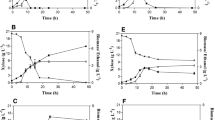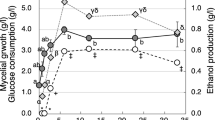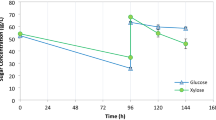Abstract
Wood hydrolysate used for ethanol production by two strains ofFusarium oxysporum contained 2.3% (w/v) reducing sugars (xylose and glucose). Ethanol production at the optimum reducing sugar concentration of 54.8 g/l medium, at pH 5.5, and 30°C was 12.3 g/l and 11.7 g/l byF. oxysporum D-140 and NCIM-1072, respectively in shake flasks during 96 h fermentation. The maximum production of ethanol under optimum cultural conditions, and in the presence of yeast extract plus minerals, was 13.2 g/l medium byF. oxysporum D-140 over 108 h fermentation.
Résumé
L'hydrolysat de bois utilisé pour la production d'éthanol par deux souches deFusarium oxysporum contenait 2.3% (poids/vol.) de sucres réducteurs (xylose et glucose). La production d'éthanol, à la concentration optimum en sucres réducleurs de 54.8 g par litre de milieu à pH 5.5 et à 30°C était de 12.3 g/l et 11.7 g/l respectivement chezF. oxysporum D-140 et NCIM-1072, en flacons agités pendant 96 h de fermentation. La production maximum d'éthanol, dans les conditions optimum de culture, et en prosence d'extrait de levure et de minéraux a mit de 13.2 g par litre de milieu chezF. oxysporum D-140 en 108 h de lermentation.
Similar content being viewed by others
References
Bailey, R.W. &Burne, E.J. 1960 Colour reactions given by sugar and diphenylamine spray reagent on paper chromatogram.Journal of Chromatography 4, 206–213.
Batter, T.R. &Wilke, C.R. 1977 A study of the fermentation of xylose to ethanol byFusarium oxysporum. University of California, Lawrence Berkeley Laboratory, Publication 6351, Berkeley, California.
Flickinger, M.C. 1980 Current biological research in conversion of cellulosic carbohydrates into liquid fuels: how far have we come?Biotechnology and Bioengineering 22, 27–48.
Jefferies, T.W. 1983 Utilization of xylose by bacteria, yeasts and fungi.Advances in Biochemical Engineering and Biotechnology 27, 1–32.
Long, S.K. &Patrick, R. 1963 The present status of the 2, 3-butylene glycol fermentation.Advances in Applied Microbiology 5, 135–155.
Miller, G.L. 1959 Use of dinitrosalicylic reagent for the determination of reducing sugars.Analytical Chemistry 31, 426–428.
Ranganna, S. 1977Manual of analysis of fruits and vegetable products. New Delhi: Tata McGraw Hill.
Reid, V.M. &Salmon, D.G. 1955 The determination of ethanol by colorimetric method.Analytical Structure 80, 704–708.
Suihko, M.L. 1984 Xylose fermentation byFusarium oxysporum and other fungi. Technical Research Centre of Finland, Publication no. 17.
Suihko, M.L. &Enari, T.M. 1981 The production of ethanol from glucose and xylose by differentFusarium strains.Biotechnology Letters 3, 723–728.
Vikari, L., Linko, M. &Enari, T.M. 1981 Ethanol from cellulosic materials. InProceedings of the International Symposium on Wood and Pulp Industry: Chemistry and Biochemistry of wood based processes and products, EUCEPA, Stockholm,4, 18–22.
Author information
Authors and Affiliations
Rights and permissions
About this article
Cite this article
Joshi, A., Garg, S.K. & Verma, J. Production of ethanol from sugars in wood hydrolysate byFusarium oxysporum . World J Microbiol Biotechnol 6, 10–14 (1990). https://doi.org/10.1007/BF01225347
Received:
Accepted:
Issue Date:
DOI: https://doi.org/10.1007/BF01225347




